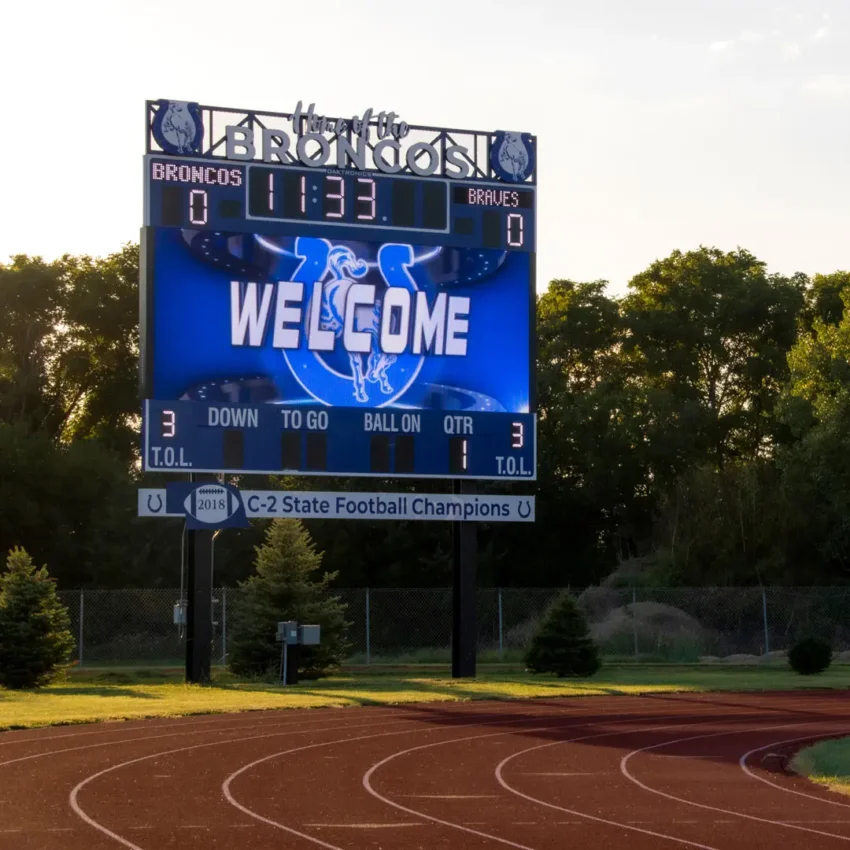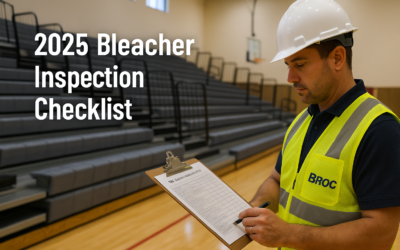When it comes to upgrading your school’s athletic facility, adding a high-quality scoreboard can make a significant impact. A school scoreboard is not only a functional component of the game but also a visual centerpiece that enhances the overall fan experience. However, with so many options available in the market, it can be challenging to determine the right school scoreboard for your specific needs. In this comprehensive guide, we will walk you through the key considerations and factors to help you make an informed decision.
Introduction
In recent years, school scoreboards have evolved significantly with advancements in technology. From traditional LED displays to full video scoreboards, there are various options available to suit different budgets and requirements. The right school scoreboard can not only provide essential game information but also create an immersive atmosphere that engages fans and enhances the overall sporting experience.
Types of School Scoreboards
Before delving into the various types of school scoreboards, it’s essential to understand the different options available. The four main types of school scoreboards are:
- Traditional LED Scoreboards: These scoreboards are the most basic option, displaying the score, time, and other game information.
- LED Scoreboards with Video Display: This type combines a traditional LED scoreboard with a video display, allowing for additional visual content such as highlights and commercials.
- Full Video Scoreboards: These scoreboards feature a complete video display, offering live action, highlights, and engaging content alongside the score and game information.
- Center-Hung Scoreboards: Suspended from the ceiling, these scoreboards hang over the center court, providing a 360-degree viewing experience for spectators and athletes.
Traditional LED Scoreboards
Traditional LED scoreboards are a popular and cost-effective option for schools looking to upgrade their athletic facilities. These scoreboards offer essential game information such as the score, time, and other relevant details. They are suitable for smaller budgets or lower-tier competitive levels.
Size and Display
The size of a traditional LED scoreboard will depend on the specific needs of your facility. Common sizes for basketball scoreboards range from 5’W x 2’H for recreational/youth soccer to 10′-12’W x 3′-6’H for high school/college-level games. It’s crucial to choose a size that ensures clear visibility for fans in all weather conditions.
Control and Operation
Traditional LED scoreboards are typically controlled using a controller or mobile app. These devices allow users to update the score, time, and other game information in real time. It’s essential to choose a scoreboard with user-friendly control options to ensure smooth operation during games.
LED Scoreboards with Video Display
For schools looking to add excitement and energy to their games, LED scoreboards with video displays are an excellent choice. These scoreboards combine the functionality of a traditional LED scoreboard with the ability to showcase video content such as highlights, commercials, and fan-engaging visuals.
Hybrid Displays
LED scoreboards with video displays are available in various sizes, ranging from recreational/youth basketball (5’W x 2’H) to high school/college-level courts (10′-12’W x 3′-6’H). The size of the video display section will depend on your specific needs and budget.
Control and Operation
LED scoreboards with video displays require two types of controllers. The first controls the LED section of the scoreboard, while the second controls the video content. It’s crucial to choose a scoreboard with user-friendly control interfaces and specialized software to ensure seamless operation during games.
Full Video Scoreboards
For schools aiming to provide the ultimate fan experience, full video scoreboards are an excellent option. These scoreboards feature complete video displays that can showcase live action, highlights, commercials, and other engaging content alongside the score and game information.
Ultimate Fan Experience
Full video scoreboards create an immersive atmosphere for fans, allowing them to enjoy the game while watching replays and engaging with visual content. These scoreboards are typically found in large arenas and stadiums but can also be suitable for schools with larger budgets and high levels of competition.
Control and Operation
Full video scoreboards require specialized software to control the video content. This software allows for real-time updates, seamless transitions between different visual elements, and the creation of unique and exciting fan experiences. It’s essential to choose a scoreboard with reliable software and user-friendly control interfaces.
Center-Hung Scoreboards
Center-hung scoreboards are the pinnacle of scoreboard technology, providing a 360-degree viewing experience for spectators and athletes. These scoreboards are suspended from the ceiling, typically positioned over the center court, and offer a comprehensive display of game information, video content, and advertisements.
360-Degree Viewing Experience
Center-hung scoreboards provide an unparalleled viewing experience, allowing fans to see the action from any seat in the venue. These scoreboards are commonly found in large arenas and stadiums but can also be suitable for schools with ample space and a desire to create a truly immersive environment.
Basketball Shot Clocks
In addition to the main scoreboard, basketball shot clocks are an important accessory for any basketball court. Shot clocks display the amount of possession time left for the attacking team to make a shot. They not only help players make decisions in real time but also add to the excitement of the game for fans.
Important Features of School Scoreboards
When choosing a school scoreboard, it’s crucial to consider the features that will enhance the game experience for both players and fans. Here are some important features to look for:
Scorekeeping
A school scoreboard should prominently display the home and visiting team scores throughout the game. This feature allows fans to easily keep track of the score and adds to the overall excitement of the game.
Game Clock Display
The game clock display shows the remaining time or the elapsed time, depending on your preference. This feature helps players make decisions in real time and adds an element of suspense for fans.
Period/Quarter Indicators
Period/quarter indicators help fans and players keep track of the flow of the game by displaying the current period or quarter. This feature is especially useful in longer games or tournaments.
Timeouts
Displaying the number of timeouts left for each team is an essential feature of a school scoreboard. It allows coaches and players to strategize effectively and keeps fans informed about the game’s progression.
Foul Indicators
Foul indicators keep track of all the fouls committed by both teams. This feature ensures fair play and allows fans to follow the game closely.
Advertisements
Scoreboards with video displays offer the opportunity to show advertisements or promote sponsors during breaks in the game. This feature can help schools monetize their game events and generate additional revenue.
Instant Replays
Some scoreboards with video displays allow for instant replays of key moments, spectacular dunks, or game-winning shots. This feature adds excitement and engagement for fans and players.
Animations/Video Content
Modern video scoreboards can display animations and video content in various formats. Schools can use this feature to create a unique and engaging fan experience, such as displaying a “kiss cam” or showcasing the school mascot.
Factors to Consider When Choosing a School Scoreboard
When selecting a school scoreboard, several factors should be taken into account to ensure the best fit for your facility. Here are some key considerations:
Resolution and Pixel Pitch
The resolution and pixel pitch of a scoreboard are crucial for determining image quality and clarity. Higher resolution and smaller pixel pitch result in sharper and more detailed visuals. However, the size of your facility and the distance between the scoreboard and the audience also play a role in determining the appropriate resolution and pixel pitch.
Level of Competition
The level of competition in your school’s athletic program will influence the type of scoreboard that best suits your needs. Younger ages and lower levels of competition may be adequately served by a traditional LED scoreboard, while higher levels may benefit from the additional features offered by video scoreboards.
Financing Options for School Scoreboards
Investing in a school scoreboard can be a significant financial commitment. Fortunately, there are several financing options available to help schools fund their scoreboard projects:
Sponsorships
Sponsorships are a popular way to finance school scoreboards. Local businesses or corporate sponsors can contribute funds in exchange for advertising space on the scoreboard or other promotional benefits.
Crowdfunding
Crowdfunding platforms provide an opportunity to raise funds for school scoreboards through donations from the community. This method allows fans, alumni, and supporters to contribute to the project and be part of enhancing the school’s athletic facilities.
Grants
Many organizations offer grants specifically for sports-related projects, including school scoreboards. Schools can explore federal, state, and local government programs, as well as private foundations, for potential grant opportunities.
Loans
Schools can also choose to finance their scoreboard projects through loans. This option allows for the cost to be spread out over time, making it more manageable for budgetary purposes. Lenders that specialize in construction projects can provide loan options with favorable rates and terms.
Choosing the Best School Scoreboard Installation Company
Selecting a reputable and experienced installation company is crucial to ensure a successful school scoreboard project. Consider the following factors when choosing an installation partner:
Reputation and References
Research the reputation of potential installation companies by reading reviews, seeking referrals, and requesting references. A reputable company should have a track record of delivering high-quality installations and providing excellent customer service.
Warranty and After-Sales Service
Inquire about the warranty offered by the installation company. A reliable warranty ensures that the company will be available for support if any issues arise with the scoreboard. Additionally, consider the availability of after-sales services, including maintenance and repairs.
Conclusion
Choosing the right school scoreboard for your athletic facility is a decision that requires careful consideration. By understanding the different types of scoreboards available, evaluating important features, and considering factors such as resolution, level of competition, and financing options, you can make an informed choice that enhances the game experience for players and fans alike. Partnering with a reputable installation company will ensure a smooth and successful installation process, allowing your school to showcase its athletic prowess with pride.




